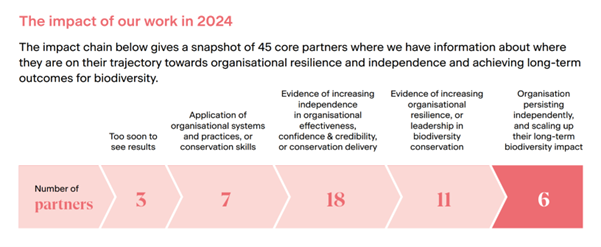Understanding the impact of a partnership-centric approach
When community-based and international actors work together in locally-led initiatives, they tend to work in partnership.
We know it’s important to shape these partnerships carefully and equitably. But how do we know it’s effective to work in this way, rather than alone?
Partnership has been at the heart of Fauna & Flora’s approach to biodiversity conservation for decades. Like others in the Bond community, we believe in the power of locally-led action. We also believe that partnerships can have a greater impact than if organisations work alone because they combine complementary skills, knowledge, ideas, resources and networks.
In fact, partnership is such a key part of what we do and how we do it that it is embedded across our Strategy to 2030. Over the past two years, we’ve been assessing how our partnership approach works to deliver sustained biodiversity conservation in a way that provides consistency and accounts for the differences in each partnership and partner.
What’s a ‘partnership’ and how do you assess its impact?
The term ‘partnership’ means different things to different people. In 2024, Fauna & Flora worked with over 430 in-country organisations to deliver our conservation work. Each of these partnerships is different, and is shaped by each organisation’s context, conservation goals, interests and skills.
Instead of defining partnerships by partner organisation type (non-governmental organisation, government, social enterprise etc.), we define them by the goal we share. For example, the aim of combining complementary skills to deliver project activities or to have greater influence through joined-up messaging.
Some partnerships have a longer-term ambition: to build a resilient, autonomous, locally-legitimate organisation which leads and sustains conservation impact into the future. This final partnership category, which we call ‘core partnerships’, requires deep investment and buy-in from both partners. Given their depth, these core partnerships were what we focused on when we assessed our partnerships’ impact.
The impact we’re looking for
Perhaps the trickiest part of assessing the impact of core partnerships is that local partners must define for themselves what ‘resilient, autonomous leadership’ looks like. There is not a single model that fits all partners.
Fauna & Flora’s broader approach to assessing impact is designed to allow for such contextual, localised complexity. We use generalised Theory of Change models to understand where our projects are on their journeys towards impact, which allows teams to understand what is or isn’t working.
These impact chains mean there is no need to impose top-down metrics, KPIs or specific methods. And we also remain mindful that Fauna & Flora is a contributor to change alongside partners and other local actors.
Based on this overarching approach, we updated our impact chain specifically for our partnerships by adding these major long-term goals:
- Effective conservation delivery led by the partner organisation
- Long-term autonomy and resilience for the partner organisation
Our updated impact chain sets out the key steps toward the goal, but each partner and partnership must define its own milestones to understand where they are on their journey.
The partnership is the vehicle for reaching our shared goal, and we remain conscious that maintaining these relationships through trust, transparency and equity is critical. As we assess impact, we also assess the quality of the partnership.
Collecting data
Once our impact assessment method was defined, we collected data. We had a head start here as our annual reporting process asks Fauna & Flora staff in every project about the activities that took place to support partners, changes in each partner’s organisational resilience or conservation impact, and the evidence for these changes. The information shared in these annual reports is a valuable starting point, but the reports don’t always capture the partners’ own perspectives.
To do this we conduct yearly interviews with a rolling sample of core partners and their Fauna & Flora partnership manager. We ask them open ended questions about what the partnership has done, the changes it has brought about, what evidence they have for those changes and the quality of the partnership. We let interviewees know we’re aiming to understand the partnership, not assess performance.
The interview data enables us to more confidently place partnerships along the impact chain. The impact chain below shows where 45 of our core partnerships were in 2024 on their journey towards delivering conservation impact and organisational resilience. (For more on this, see our 2024 Conservation Impact Report, and more examples of our work on organisational resilience can be found here.)

Analysing the 2024 partner interviews highlighted various impacts from our shared work over time, including changes in communities’ attitudes toward conservation, increases in populations of key species, recognised community protected areas and increasing in-country partner recognition and impact.
We are aware that partnership impact is not linear, and it can be slow or intangible. A major internal change at either organisation may mean the partnership moves backward along the impact chain. We’ll be tracking the stage of each partnership over time to better understand these ebbs and flows, recognising they are a natural part of any relationship.
What we’re learning
These interviews also provide rich learning about what we’re doing well and where we can improve our partnership practice. Some of our key takeaways from the 2024 interviews include:
- Impact arose from each partner playing different, complementary roles.
- Personal relationships matter. Stronger partnerships, where we coordinate and use our complementary resources effectively, involve trust between individuals. So, the way we interact with each other in partnership shapes the potential for impact.
- Working in partnership requires an investment of time and good communication. Partnership becomes more challenging when that time isn’t available. When both partners can invest time and maintain strong communication, partnership impact deepens.
Category
News & views
